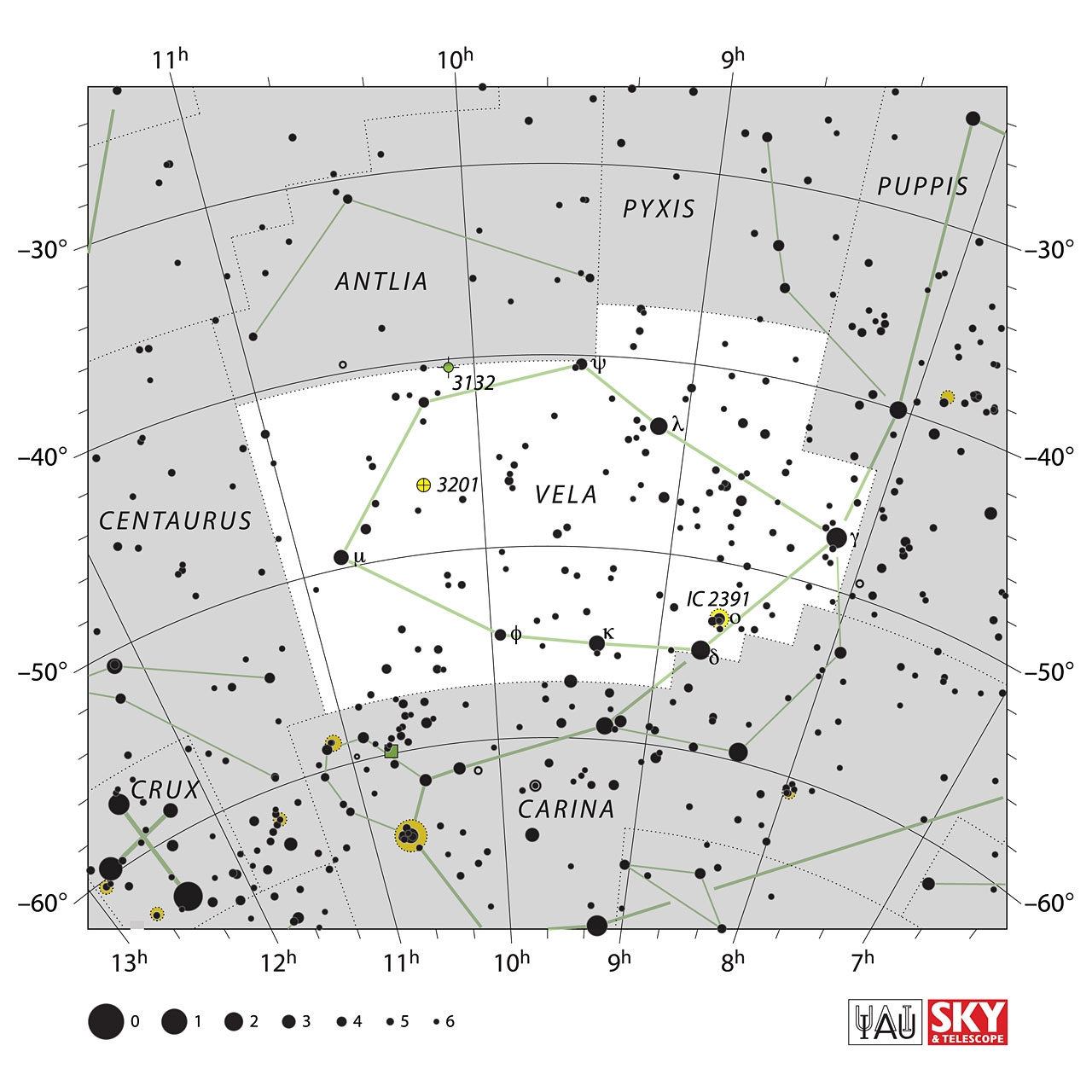Vela


Vela is visible in the southern evening sky in the months around February. The Milky Way runs through it and so it is home to numerous open clusters, including fifteen which are brighter than tenth magnitude.
The stars δ-Vel and κ-Vel, together with Avior and Tureis, form the False Cross, an asterism which is easily mistaken for the nearby Southern Cross in Crux.
Until the eighteenth century, Vela was part of the much larger ancient constellation of Argo Navis, listed by Ptolemy among his 48 constellations in the second century. Argo Navis covered over 4% of the sky, an area 25% larger than the biggest modern constellation, Hydra.
In 1763, Nicolas Louis de Lacaille divided it up into three parts: Carina, Puppis and Vela. As a result of this relatively recent subdivision, the Bayer designations (α, β, γ, etc) are split between the stars of the three constellations.
In classical mythology, Argo Navis was the ship sailed by Jason and the Argonauts on their voyage to recover the golden fleece. Vela represents the ship’s sail.
In Indian astronomy, Vela is known as ನೌಕಾಪಟ (Naukapata)
Vela contains:
-
Stars
- γ²-Vel (mag 1.8)
- δ-Vel (mag 1.9)
- Suhail (mag 2.2)
- κ-Vel (mag 2.5)
- μ-Vel (mag 2.7)
- N Vel (mag 3.2)
- φ-Vel (mag 3.5)
- o Vel (mag 3.6)
- ψ-Vel (mag 3.6)
- c-Vel (mag 3.7)
- b-Vel (mag 3.8)
- q-Vel (mag 3.8)
- p-Vel (mag 3.8)
- a-Vel (mag 3.9)
- d-Vel (mag 4.1)
- e-Vel (mag 4.1)
- γ¹-Vel (mag 4.2)
- x-Vel (mag 4.3)
- M-Vel (mag 4.3)
- i-Vel (mag 4.4)
- w-Vel (mag 4.5)
- J-Vel (mag 4.5)
- GZ Vel (mag 4.6)
- m-Vel (mag 4.6)
- k-Vel (mag 4.6)
-
Open Clusters
- IC 2391 (mag 2.5)
- IC 2395 (mag 4.0)
- NGC 2547 (mag 4.7)
- NGC 3228 (mag 6.0)
- NGC 2669 (mag 6.1)
- NGC 2910 (mag 7.2)
- NGC 2645 (mag 7.3)
- NGC 3330 (mag 7.4)
- IC 2488 (mag 7.4)
- NGC 2670 (mag 7.8)
- NGC 2925 (mag 8.3)
- NGC 2659 (mag 8.6)
- NGC 3033 (mag 8.8)
- NGC 2660 (mag 8.8)
- NGC 3105 (mag 9.7)
- NGC 2972 (mag 9.9)
- NGC 2671 (mag 11.6)
- NGC 2849 (mag 12.5)
- NGC 3446
- NGC 2866
-
Globular Clusters
- NGC 3201 (mag 6.7)
-
Galaxy
View Vela in 3D 
Source: Wikipedia, in-the-sky.org
Image Courtesy: Sky&Telescope & IAU, Illustration Images linked from Urania's Mirror on Wikmedia Commons by Sidney Hall
Image Courtesy: Sky&Telescope & IAU, Illustration Images linked from Urania's Mirror on Wikmedia Commons by Sidney Hall
